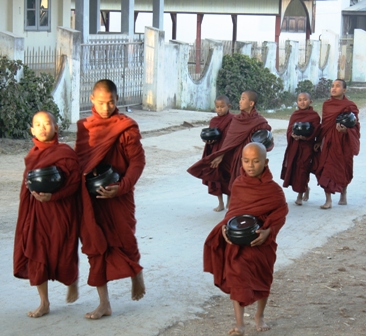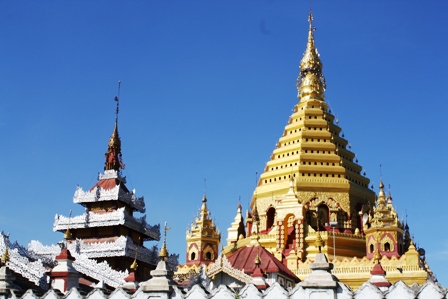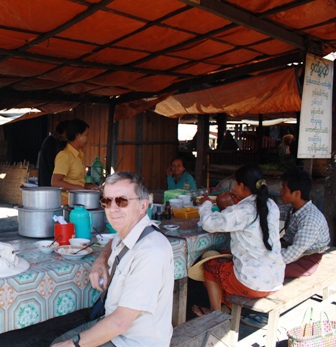
Click the photo above to see an album of photos. To return to our website close the window.
Read previous Biking the Lake or next Road to Mandalay
7 January 2010 Nyaungshwe Myanmar
It is 7 AM, I have on two fleeces and I can see my breath. My wait is rewarded. It is just like the many paintings for sale in the shops. A single line of barefoot red robed monks each holding a black begging bowl come striding down the road to the doors of one of the large monasteries in the town of Nyaungshwe, at the north end of Inle Lake. Each one pauses at the door to receive a scoop of rice ladled out of a large pot by a nun from the women’s monastery across the road. There are about 500 monks in this small town and every morning starting at 6:45 AM they leave their individual monastery and march along the dirt roads to the designated monastery for morning prayers. It is quite a sight. Most are very well disciplined but the youngest and last group, some only 10 years old, straggles along in groups. Single file is too much for them.
Nyaungshwe is a small, laidback market town with many guesthouses and small restaurants for the economy class tourists, of which we are two, who come to visit Inle Lake. The town is conveniently located on a main channel leading to the shallow, 13.5 mile by 7 mile lake surrounded by more than 1000 pagodas (temples).
You would think that Inle would be hot and steamy but it is not. It is at a higher elevation than Yangon and Mandalay and as soon as the sun goes down behind the hills flanking the lake, the temperature drops. The day we arrived was warm and sunny but that night we were wearing our fleece and glad of a heavy quilt for a bed. The temperature did moderate during our visit but it was still cool at night.
Very few roads are paved in town. Most of them are dusty dirt streets, more suited to the horse carts, ancient cars and trucks, trishaw pedicabs, Chinese bicycles and motorcycles that provide transportation around town. Old pickup trucks with benches along the sides are buses to the surrounding villages. We have been in town for 4 nights, having flown from Yangon, and would stay longer if we had more time.

Puppetry is alive and well in Myanmar. Elaborately dressed marionettes play out traditional stories and dances. We found a puppet master in his small theatre in the front room of his house. Ray and I were the only audience for the evening and had time to find out that the puppeteer was justly of his 1994 first prize award in a national puppet master contest in Mandalay. He told us he is the fourth generation of puppet masters and is training his two teenaged children the art. The performance was most enjoyable. There were seven traditional dances expertly performed by different marionettes. Recorded music and an English commentary prepared us for each dance. We hope more people find his small theatre and keep him in business.

A Frenchman and his Dutch wife were eating at the food stall during our second visit. It was obvious he was familiar with the woman who ran the shop and her son, who spoke good English. The Frenchman was invited to their home for dinner that night. They were unavailable so we were invited instead. How could we refuse?
The son picked up in his trishaw that evening and drove us a few km out of town to his mother’s simple stilt home next to a large orphanage run by a Catholic priest. We took off our shoes to climb open wooden stairs to the living level. The walls were woven bamboo, typical of this area, with a large living room and two smaller curtained off rooms. A low table was set in the middle of the large room, already arrayed with six dishes of food. Since there was no electricy yet, the son lit a candle and set it on the table. We were invited to sit on grass mats on the floor and more dishes of food were brought for us. It was a veritable feast. We helped ourselves to steamed rice and sampled all the offered dishes. There was chicken, pork, cauliflower, greens, a delicious tomato based salad, all served with various condiments and sauces. Dessert was guacamole, which comes with most meals in her restaurant. We had an audience of three little grand daughters who live in nearby houses and chatted with the son, as the mother spoke very little English. At the end of the meal we thanked our hostess, paid her for the meal, which was worth far more than we gave her, and returned to our guesthouse by trishaw. Visiting a family in their home is always an opportunity not to be missed. What better way to find out more about the country and how ordinary people live.